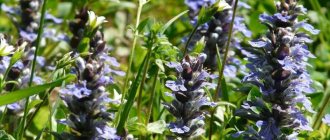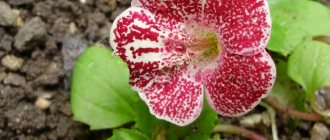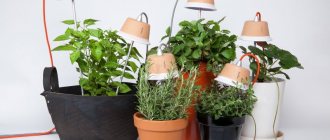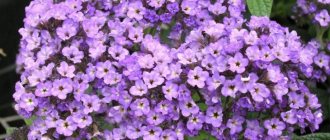The Coleus plant is a member of the Lamiaceae or Lamiaceae family. This genus includes approximately 150 species. Its name was derived from the word “kleos”, which is translated from Greek as “case”. In nature, species of such plants can be found in the tropical forests of Africa and Asia. Sometimes inexperienced gardeners call coleus the "poor man's croton" because its variegated foliage is similar to croton leaves, but it looks less impressive. This flower is also called a “garbage plant,” but this is done only by those gardeners who are unfamiliar with new varieties of coleus, which are highly decorative. They can compete with both croton and other popular decorative foliage plants. Besides the fact that coleus has spectacular foliage, it is very easy to care for.
Brief description of cultivation
- Bloom . Coleus is cultivated as an ornamental foliage plant.
- Landing . Seeds for seedlings are sown in the last days of March, and seedlings are planted in the soil in the second half of May.
- Illumination . Before noon, the flower needs a lot of bright sunlight, and then it needs a little shading.
- Temperature regime . In the summer - from 18 to 20 degrees, and in the winter months - no colder than 12 degrees.
- Watering . Moisten the soil frequently and abundantly.
- Air humidity . It needs high air humidity, so the bush should be frequently moistened with a spray bottle, especially on hot days.
- Fertilizer . During the spring-summer period, the flower is fed once every 7 days, and in winter - once every 4 weeks. For this purpose, a mineral complex fertilizer is used.
- Pinching . During the growing season it is carried out systematically.
- Trimming . The bush is pruned after the dormant period ends, at the very beginning of active growth.
- Rest period . In winter time.
- Transplant . Regularly once every 3 or 4 years.
- Reproduction . By cuttings and seed method.
- Pests insects . Aphids, whiteflies, mealybugs and spider mites.
- Diseases . Stem and root rot.
Soil selection
The choice of soil is also one of the important points for planting coleus. In principle, the composition itself can be anything, but the presence of nitrogen and nutrients in the soil is mandatory. This promotes full growth and development of beautiful, bright leaves with a more pronounced stencil pattern.
For the seeds to germinate, the most nutritious mixture will be:
- 4 servings of black soil;
- 2 portions of pine needles;
- 2 servings of cow manure;
- 1 portion of sand.
The soil for preparing the mixture should be thoroughly warmed and sifted. In order for the plant to grow for sure, it is worth planting the seedlings in separate containers, and after germination, transplant them into the ground in the garden.
Features of Coleus
The tetrahedral ribbed shoots of coleus at the base become lignified. The opposite, heart-shaped leaf blades are pubescent and have a serrated edge. Some species have small leaves, but among them there are those whose foliage can reach a length of about 15 centimeters. In natural species, the foliage and shoots are very similar in appearance to nettles; therefore, the flower is also popularly called “nettle.” The color of the leaf blades is a different combination of burgundy, red, green and yellow. During flowering, a spike is formed, consisting of small flowers of lilac or blue color, but they do not represent any decorative value. Coleus is grown as an ornamental foliage plant, but among the various species and varieties of this plant there are also beautifully flowering ones.
How to grow coleus. Video channel Garden World
Bloom
How does coleus bloom? Why are flower stalks removed? The flowers of the plant are inconspicuous, purple or bluish, blooming on the tops of long shoots. They are collected in false whorls, which form a spike-shaped inflorescence.
Flowering lasts from June to September. After this, nut-shaped fruits with small seeds are formed. Under natural conditions, coleus blooms throughout the year. Some varieties do not set seeds.
Growing coleus in the garden
Sowing
Coleus is popular because it is very beautiful and also easy to care for. And also because homemade coleus can be grown in your garden plot in the warm season. This plant can be easily grown from seeds, and in specialized stores, if desired, you can find excellent Dutch or English variety mixtures.
It is recommended to sow seeds in the last days of March. You can sow seeds earlier or later, but in this case, during the cold season, the seedlings will require additional supplementary lighting. A low box that is filled with a light soil mixture rich in nutrients is ideal for sowing. Distribute the seeds evenly on the surface of the soil mixture and moisten the crops from the sprayer; there is no need to embed them in the substrate. Sprinkle the seeds on top with a thin layer of sand and cover the box with glass (film). Move the crops to a dark and warm place, making sure that the surface of the substrate in the box is slightly damp at all times. Good purchased seed material has a high germination rate; sometimes a sprout appears from each seed.
The first seedlings should appear just 1–1.5 weeks after sowing. As soon as this happens, remove the shelter and move the box to a well-lit place, protected from direct sunlight; a western or eastern window sill is perfect. The air temperature should be maintained at 17 to 19 degrees.
Coleus - growing from seeds
Growing seedlings
After the seedlings are 20–30 days old and have formed their first pair of true leaf blades, they will need to be picked into special cassettes. Thanks to this, the plants will be able to form a well-developed, powerful root system that will not be damaged during transplantation. Young bushes aged 5 to 6 weeks will require mandatory transplantation into individual 400 g glasses, after which they are pinched so that they grow bushier.
Transplanting
Seedlings can be planted in open soil only when warm weather sets in and return frosts are left behind. An area suitable for planting coleus should be sunny, but in the afternoon it should be slightly shaded. The flower also needs an area well protected from gusts of wind. Prepare the planting holes and fill them with a nutritious soil mixture that allows water and air to pass through well. Plant seedlings from cups in them.
Planting and growing coleus is relatively simple, especially if you cultivate it as an annual. If you decide to grow it as a perennial, then keep in mind that after 2 or 3 years the bush will lose its decorative effect, and you will have to grow young plants from cuttings or seeds. You should also remember that with the onset of autumn, the flowers will have to be dug up, planted in pots and brought into the house, and in spring they will be planted again in the garden.
Plant the seedlings on the prepared area, and the distance between them should not be very large. After this, they are watered abundantly.
GROWING Dwarf Coleus. COLEUS PICK!
Caring for coleus in the garden
In order for coleus to grow well in the garden, it must be watered abundantly, especially when there is a hot, dry period. For irrigation, it is recommended to use well-settled water, so you need to install a large tub or barrel in the garden plot; it can be used to accumulate rainwater or to settle tap water. When the flowers are watered, loosen the surface of the soil around them and pull out all the weeds.
In order for the bushes to grow more luxuriant, they should be lightly trimmed 2 or 3 times throughout the season. During the growing season, coleus growing in the garden should be systematically fed once every 7 days, using fertilizer with a high nitrogen content. Thanks to this, foliage will actively grow and develop, and flowering will be inhibited. As soon as the inflorescences begin to form, cut them off so that the coleus does not waste its energy on their growth and flowering. In this simple way you can grow a lush and spectacular coleus bush in the garden.
general information
The colloquial name for coleus, which it received for the expressive shape of its leaves, is weed. In the apartment the flower grows like an unpretentious perennial, but in the garden it will not survive the winter. And all because in nature it lives in Africa and Asia - regions with hot climates and no frost.
Coleus was brought to Europe on purpose and they immediately started breeding it. The first wild species amazed sailors so much that they brought them straight from the island of Java. So, since the nineteenth century, the popularity of the flower in the world has grown rapidly.
Photo: domashniecvety.ru
Coleus leaves can be the most unexpected colors: orange, red, burgundy. Most often, they combine several shades at once: for example, grassy green with purple. Together with the unusual shape of the plates, it looks very impressive and exotic!
Although it doesn't bother gardeners too much, coleus does have flowers. They are just small, faded and inconspicuous, whitish or blue. They are not particularly attractive, so it is better to remove the buds at the bud, otherwise they will draw almost all the nutrients onto themselves. Because of this, during flowering, the coleus leaves become smaller and fade.
Photo: flo.discus-club.ru
Coleus at home
How to grow from seeds
Coleus can be grown not only in the garden, but also at home, and it can also be propagated either by cuttings or by seed. Such a flower is grown from seeds in the same way as seedlings for planting in open ground. However, after the seedlings are picked into separate cassettes, they are then transplanted into individual pots. Next, they begin to care for the bushes in the same way as adult plants.
Reproduction by cuttings
When pruning an adult bush, the remaining trimmings can not be thrown away, but used as cuttings. The length of the cutting should be approximately 10 centimeters; tear off all the leaf plates from its lower part. After this, it is planted in moistened sand or substrate for rooting; the segments must be covered with a cut plastic bottle or a transparent bag on top. Place them in a shaded area and keep them cool (18 to 20 degrees). Rooting takes 1–1.5 weeks, after which the cuttings that have given roots can be planted in a permanent place. It is very easy to propagate coleus this way.
Coleus care tips for formation, flowering, cuttings
Coleus care at home
To successfully grow indoor coleus, it is enough to provide it with the correct watering regime. To do this, it is regularly watered abundantly using soft, well-settled water, the temperature of which should be close to room temperature. Particular attention should be paid to watering in spring and summer. You need to feed homemade coleus, like garden coleus, once a week during the spring-summer period. To do this, use complex mineral fertilizer in half the dose recommended by the manufacturer. In the cold season, fertilizing is carried out once every 30 days.
In spring and summer, it is recommended to systematically moisten the bush with a spray bottle. However, it is impossible to moisten the foliage in direct sunlight. In winter, when the air in the room is dried out by operating heating devices, to increase its humidity level, moistened expanded clay is poured into the tray, and a pot with a plant is placed on it. Trim off the inflorescences that have begun to form in a timely manner; they are left only if an ornamental flowering species or variety is grown. During the growing season, the bushes will need to be pinched several times, in this case they will be more lush. After the dormant period ends, before the growing season begins, carry out anti-aging pruning; to do this, shorten all stems to 50–70 mm. Experienced gardeners recommend rooting several cuttings remaining after pruning. The fact is that last year's bush may lose its decorative effect.
Reproduction
Cuttings
Autumn is a good time to collect cuttings. Propagation of coleus by cuttings, that is, by rooting fragments of shoot tips, is the most effective and simplest way for this exotic plant.
Work progress:
- Cut off healthy, strong shoots growing in the center of the bush. The taken sections should have a length of 7-10 cm and 2-3 pairs of leaves.
- Remove the lower parts of the leaves to prevent rotting and concentrate the plant's energy on root production.
- The cuttings can be placed in water or in a substrate consisting of a mixture of garden soil, peat and sand. Before placing it in the ground, it is worth dipping the lower tip of the shoot into a rooting agent, for example, Kornevin, to stimulate the plant to quickly form roots. However, such a procedure is not necessary; coleus takes root well even in water without special preparations.
- The condition for proper rooting of cuttings is to ensure appropriate environmental conditions: a bright, warm place with a temperature of 22-24 degrees C and regular watering. Cuttings also take root well in ordinary water; the photo below shows the roots of coleus 5 days after the start of rooting in water.
- The cuttings take root quickly and should have a new root system in about 2 weeks. When the plants begin to grow, it makes sense to pinch the tops, this will help the plants develop well.
Seeds
Seeds for sowing coleus can be purchased or collected from your own plants, but seedlings obtained from self-collected seeds may not replicate the parental characteristics. Coleus seeds must be healthy. You should also know that the formation of seeds weakens the plant and reduces its decorative value. Therefore, it is better to pick off faded flowers to prevent fruit formation.
Coleus Blume produces spherical brown seeds, very small, about the size of a poppy. The seed material must be well dried, have a uniform color, and the seeds must be the same in size.
Coleus sowing time: seeds are sown from February to April in a greenhouse or in pots placed in a warm room.
Sowing Coleus Seeds:
- We fill the container with permeable substrate, level the soil, and water it.
- Small coleus seeds are sown in rows, to a depth of 1-3 mm, every 10-15 cm, and then sprinkled with soil. You can mix them with sand before sowing, this will make sowing easier, since the seeds are very small.
- After sowing, we moisten the soil, preferably with a spray bottle, so that the seeds do not fall deep into the ground with the flow of water. You can cover the container with a lid or film to improve germination conditions. The lid should be removed periodically, the container should be ventilated, and the soil should be slightly moistened. In addition to high humidity, young plants should be provided with a fairly high temperature: 21-22 °C during the day, 15-18 °C at night.
- Germination occurs faster at temperatures of 20-27 °C, seedlings appear in 7-14 days.
- When the seedlings develop the first pair of cotyledons, we plant them at a distance of 5 × 5 cm or into separate pots.
- Grown seedlings are transplanted into balcony boxes, pots or open ground. It is worth planting in open ground in the middle zone after May 15, after the last frost.
After 6-7 weeks of cultivation, when the plants reach 10-12 cm, the tops of the shoots should be pinched so that the plants bush beautifully.
Diseases and pests
If young coleus is not pinched or trimmed in a timely manner, its stems will become elongated. Also, a young bush can stretch out due to poor lighting, and this can also happen to an old flower. If the light is too intense, the foliage becomes faded and loses its color. If watered incorrectly, the bush begins to shed its leaves. This occurs both with excessively poor watering and due to stagnation of liquid in the root system.
Among the insects that can harm coleus are spider mites, aphids and whiteflies. Aphids suck the sap from the bush, which causes yellowing and shrinking of the affected leaf blades. This pest is also considered the main carrier of dangerous diseases. To destroy it, the home plant is sprayed with a soap solution. If necessary, the treatment is repeated after 7 days. Remember that when spraying a bush with a soap solution, the surface of the substrate in the pot must be protected with film. If aphids settle on garden bushes, they will have to be treated with a solution of a special insecticidal agent, for example, Fitoverma or Aktellika. In order to save coleus from spider mites, it is sprayed with Apollo, Akarin, Oberon or Agravertine. To combat whiteflies, they use the same means as to exterminate aphids: Aktara, Aktellik, Oberon and others.
The use of chemicals can greatly harm coleus, which is why it is so important to follow simple rules of prevention. It has long been known that healthy and strong plants are avoided by pests, so take care of the flower properly and provide it with suitable conditions for growth.
Planting seedlings in open ground
A place for planting coleus should be chosen that is well-lit, with slight shading, and a completely shady area will not allow the leaves to show their natural brightness. Protection from the wind should also be taken into account - there should be no drafts.
Important! Some varieties prefer sunny areas, without shade, since light plays a big role in the color of the leaves. For example, red or burgundy leaves love sunny places, while leaves with green colors love partial shade.
Coleus seedlings are planted in holes dug at a distance from each other - the distance depends on the decor option. In each you need to put peat or compost (a handful). Afterwards, the plants are watered with settled water.
Coleus in winter
Coleus is most often grown in the garden as an annual plant. However, if desired, a garden bush can be removed from the ground and planted in a pot, which is brought into the house. In this case, they care for it in the same way as for domestic coleus. With the onset of autumn, gradually reduce watering, while adding fertilizers to the soil mixture once every 30 days. The same care should be provided for homemade coleus. Also, during the winter months the flower should be kept cool (from 8 to 15 degrees).
There are 10+ varieties of coleus in winter!!! :) Where to place them??
Application
Coleus look spectacular both in flower beds and in containers. They can be planted individually in pots, combined into multi-colored groups, or created in multi-species compositions in which the unique color of the leaves will create an interesting effect. Multi-colored varieties can be used as an autumn accent in compositions that sometimes lose their appeal in late summer. The coleus flower with colorful leaves adds variety to the design of a terrace or balcony and is an ideal partner for petunias and other flowering plants.
You can plant several seedlings in one container, each a different color. There are so many variations that every year you can create a new composition. Coleus, with leaves in warm shades of red, orange, purple or brown, are eye-catching and attention-grabbing.
Low varieties are well suited for seasonal flower beds. They look good planted as seasonal borders, creating low plant borders. In flower beds, they can be periodically planted in empty spaces left by some perennials that disappear after flowering (for example, oriental poppy, lupins).
Types and varieties of coleus with photos and names
Hybrid coleus (Coleus x hybridus)
This species is most often cultivated at home. It is a small bush, distinguished by its unpretentiousness and low maintenance requirements. The bush can reach a height of about 100 cm, the cross-section of the shoots is square. The elongated oval leaf blades have a serrated edge. If the bush grows in a shaded place, then its leaves are green. If it is grown in a sunny place, then the color of the leaves will be burgundy.
Coleus rehneltianus
This species is native to Sri Lanka and is cultivated as an hanging plant. The stems can reach about half a meter in length. The long-petioled opposite leaf blades have a broad heart-shaped shape and a wavy edge. The foliage is decorated with veins that can be painted in various colors, for example: purple, red, yellow, brown, etc.
Coleus blumeii
This species is the most popular in culture, as well as its varieties, of which there are quite a few. This plant is native to Southeast Asia. This subshrub has stems reaching a height of up to 0.8 m, which at the base become lignified over time. Popular varieties:
- Black dragon . The violet-brown leaf blades, grooved along the edges, are decorated with red veins.
- Hybrids of the Vizzard series . Wizzard Gold has light-yellow foliage, Wizzard Evening Dawn - leaf blades of a fiery red hue have a narrow pale green border, Wizzard Jade - white leaves are decorated with a wide border of green.
BEAUTIFUL COLEUS! SUBTLES OF GROWING!
Interesting varieties
In cultivation there are varieties often designated as Coleus × hybridus. One can write endlessly about the beauty of these plants, as new varieties are constantly appearing, with original, colorful leaves.
The most attractive are variegated varieties, green-yellow-carmine, pink-green, salmon-pink, brownish-red with yellow edging, beet with green spots.
There are many cultivars on the market bred for specific characteristics - size or pattern, leaf color - from light green to various shades of pink, burgundy, purple to dark, almost black (for example, Coleus Dark Star).
The patterns on the leaves come in a whole range of shades of yellow, and can also be white.
- "Electric Lime" Electric Lime - light green leaves with a lemon vein;
- "Florida Sun Rose" Florida Sun Rose - green-pink-purple leaves;
- "Gatar Glory" Gatar Glory - yellow-orange leaves;
- “Pink Chaos” Pink Chaos – green-white-pink leaves;
- “Splish splash” Splish Splash – green-burgundy leaves;
- "Wasabi" Wasabi – green leaves;
- "Bronze Age" Bronze Age - with copper-round leaves, compact shape;
- "Caipirinha" Caipirinha - with lemon leaves, burgundy vein;
- "Golden Dreams" Golden Dreams - lemon leaves with a red vein;
- “Pineapple Splash” Pineapple Splash – lemon leaves with burgundy spots;
- "Sky Fire" Sky Fire - with velvety, burgundy leaves with a bright green edge;
- “Walter Turner” Walter Turner – burgundy-red-green;
- Wizard Scarlet - purple with light green border;
- "Battemilk" Buttermilk - jagged, yellow-green leaves;
- “Religious Rutabaga” Religious Rutabaga – variegated, purple-green-cream;
- “Timotei” Timotei – creamy green;
- "Melibu Apricot" Malibu Apricot - apricot-yellow leaves;
- "Wild Lime" Wild Lime - strongly wavy, creamy green leaves;
- "Black Prince" Black Prince - very dark, almost black leaves;
- "Kong Rose" Kong Rose - with large, red-burgundy-lime leaves.
Hybrid coleus, or Bloom's Coleus hybrids (Coleus hybrida, Coleus hybridus)
A perennial plant with stems that become woody in the lower part, they are used in the garden as summer gardens, grown at home in a perennial crop, or seasonally stored as a mother plant for a summer flower garden.
Popular varieties and series of coleus
The F1 Kong series of coleus hybrids is distinguished by its rapid growth and bush shape (35–40 cm in height) with very large, varied leaves:
- green with cream veins (Green),
- green with dark burgundy and bright red veins (Red),
- bright green with dark pink (Rose),
- tricolor with red central veins (Scarlet),
- unique bright green with stripes and spots of red and cream (Mosaic).
Coleus Butterfly - wavy leaf;
Coleus variety Rose Blush
coleus Golden Bedder - yellow, solid leaves;
Coleus Glory of Luxembourg - sandy-coral strokes on the yellow background of the leaf;
Coleus variety Royal Scot
Coleus Candidum - the center of the leaf is white-yellow, the edge is light green;
Coleus varieties Brilliant and Buttercup
Coleus Volkano - dark red leaf, plain;
Coleus Salmon Lace - the center of the leaf is red, the edge is green-yellow;
Coleus Firebird - corrugated leaf;
Coleus variety Crimson Ruffles
Coleus Saber is a dwarf variety of coleus up to 25 cm high.











